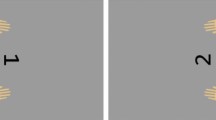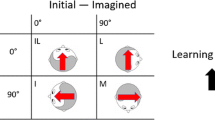Abstract
In the course of spatial representation, the choice of intrinsic axis depends on various spatial and non-spatial properties. The main purpose of the current study is to investigate how people choose the intrinsic axis in a virtual reality environment with spatial cues from different categories. Sixty-four participants (32 males and 32 females) each took part in one of two experiments. In each experiment, participants learned a layout comprising seven objects and viewed the scene through a head-mounted display from two perspectives. They then completed partial-scene-recognition tasks. Experiment 1 used objects lacking intrinsic orientations, and the directions of the symmetric axis (45°–315°) and the vertical side (0°–180°) of the mat were incongruent. Experiment 2 used avatars whose orientations were all aligned with the vertical mat side. Response patterns showed that the axis which was consistent with the initial learning perspective was chosen as the intrinsic axis in Experiment 1, while in Experiment 2, the 0°–180° axis was chosen. The results indicated that people would choose the intrinsic axis according to their original egocentric experience when there were two conflicting geometric cues of different categories, but if there were three geometric cues, the axis that was consistent with more cues was more likely to be chosen as intrinsic axis.





Similar content being viewed by others
References
Chen XL, McNamara TP (2011) Object-centered reference systems and human spatial memory. Psychon Bull Rev 18(5):985–991. https://doi.org/10.3758/s13423-011-0134-5
Kelly JW, McNamara TP (2008) Spatial memories of virtual environments: how egocentric experience, intrinsic structure, and extrinsic structure interact. Psychon Bull Rev 15(2):322–327. https://doi.org/10.3758/PBR.15.2.322
Kelly JW, Sjolund LA, Sturz BR (2013) Geometric cues, reference frames, and the equivalence of experienced-aligned and novel-aligned views in human spatial memory. Cognition 126(3):459–474. https://doi.org/10.1016/j.cognition.2012.11.007
Li J, Su W (2015) The limited effect of coincident orientation on the choice of intrinsic axis. Percept Mot Skills 120(3):895–905. https://doi.org/10.2466/24.23.PMS.120v15x4
Li J, Zhang K (2011) The effect of orientation coincidence of objects on intrinsic frame of reference system in symmetrical scene. Acta Psychol Sin 43(3):221–228. https://doi.org/10.3724/SP.J.1041.2011.00221
Li J, Zhang K (2012) Coincident orientation of objects and viewpoint-dependence in scene recognition. Percept Mot Skills 114(1):301–309. https://doi.org/10.2466/22.24.27.PMS.114.1.301-309
Li XO, Mou WM, McNamara TP (2009) Intrinsic orientation and study viewpoint in recognizing spatial structure of a shape. Psychon Bull Rev 16(3):518–523. https://doi.org/10.3758/PBR.16.3.518
Li XO, Carlson LA, Mou WM, Williams MR, Miller JE (2011) Describing spatial locations from perception and memory: the influence of intrinsic axes on reference object selection. J Mem Lang 65(2):222–236. https://doi.org/10.1016/j.jml.2011.04.001
Li J, Su XY, Wang Y, Liu C, Chen QR (2017) The effect of different object orientation conditions on the construction of intrinsic frame of reference system in virtual scene. J Psychol Sci 40(6):1322–1327. https://doi.org/10.16719/j.cnki.1671-6981.20170607
Liu XY, Mou WM, McNamara TP (2012) Selection of spatial reference directions prior to seeing objects. Spat Cogn Comput 12(1):53–69. https://doi.org/10.1080/13875868.2011.586758
Liu XY, Liu SQ, Wang C (2014) The temporal characteristics of selecting spatial reference directions. Stud Psychol Behav 12(4):469–475. https://doi.org/10.3969/j.issn.1672-0628.2014.04.006
Marchette SA, Shelton AL (2010) Objects properties and frame of reference in spatial memory representations. Spat Cogn Comput 10(1):1–27. https://doi.org/10.1080/13875860903509406
Mou WM, McNamara TP (2002) Intrinsic frames of reference in spatial memory. J Exp Psychol Learn Mem Cogn 28(1):162–170. https://doi.org/10.1037/0278-7393.28.1.162
Mou WM, Zhao MT, McNamara TP (2007) Layout geometry in the selection of intrinsic frames of reference from multiple view points. J Exp Psychol Learn Mem Cogn 33(1):145–154. https://doi.org/10.1037/0278-7393.33.1.145
Mou WM, Fan YL, McNamara TP, Owen CB (2008) Intrinsic frames of reference and egocentric viewpoints in scene recognition. Cognition 106(2):750–769. https://doi.org/10.1016/j.cognition.2007.04.009
Mou WM, Liu XY, McNamara TP (2009) Layout geometry in encoding and retrieval of spatial memory. J Exp Psychol Hum Percept Perform 35(1):83. https://doi.org/10.1037/0096-1523.35.1.83
Papadakis G, Mania K, Coxon M, Koutrouli E (2011) The effect of tracking delay on awareness states in immersive virtual environments: an initial exploration. In: Processing of the 10th international conference on virtual reality continuum and its applications in industry, vol 72. ACM, pp 475–482. https://doi.org/10.1145/2087756.2087848
Richard L, Waller D (2013) Toward a definition of intrinsic axes: the effect of orthogonality and symmetry on the preferred direction of spatial memory. J Exp Psychol Learn Mem Cogn 39(6):1914–1929. https://doi.org/10.1037/a0032995
Rump B, McNamara TP (2013) Representations of interobject spatial relations in long-term memory. Mem Cogn 41(2):201–213. https://doi.org/10.3758/s13421-012-0257-6
Shelton AL, McNamara TP (1997) Multiple views of spatial memory. Psychon Bull Rev 4(1):102–106. https://doi.org/10.3758/BF03210780
Shelton AL, McNamara TP (2001) Systems of spatial reference in human memory. Cogn Psychol 43(4):274–310. https://doi.org/10.1006/cogp.2001.0758
Sluzenski J, Meneghetti C, McNamara TP (2011) Spatial influence of environmental axes in a baseball field. Spat Cogn Comput 11(3):205–225. https://doi.org/10.1080/13875868.2010.542262
Tamborello FP, Sun Y, Wang H (2012) Spatial reasoning with multiple intrinsic frames of reference. Exp Psychol 59(1):3–10. https://doi.org/10.1027/1618-3169/a000119
Valiquette CM, McNamara TP, Labrecque JS (2007) Biased representations of the spatial structure of navigable environments. Psychol Res 71(3):288–297. https://doi.org/10.1007/s00426-006-0084-0
Xie CX, Li SY, Tao WD, Wei YP, Sun HJ (2017) Representing spatial layout according to intrinsic frames of reference. Psychol Rep 120(5):846–869. https://doi.org/10.1177/0033294117711129
Zhang HP, Deng Z, Chen QR, Li J (2014) The effect of object similarity on spatial representation: evidence from eye movements. J Psychol Sci 37(6):1321–1327. https://doi.org/10.16719/j.cnki.1671-6981.2014.06.009
Funding
The project was supported by National Natural Science Foundation of China (31200776) and Natural Science Foundation of the Higher Education Institutions of Jiangsu Province (17KJD190002).
Author information
Authors and Affiliations
Corresponding author
Ethics declarations
Conflicts of interest
All the authors declare that they have no conflict of interest.
Ethical approval
The study was supported by the IRB of Nanjing Normal University. All procedures performed in studies involving human participants were in accordance with the ethical standards of the institutional and national research committee and with the 1964 Declaration of Helsinki and its later amendments or comparable ethical standards.
Informed consent
Informed consent was obtained from all individual participants included in the study.
Additional information
Publisher's Note
Springer Nature remains neutral with regard to jurisdictional claims in published maps and institutional affiliations.
Electronic supplementary material
Below is the link to the electronic supplementary material.
Rights and permissions
About this article
Cite this article
Li, J., Xie, N. & Zhao, W. The choice of intrinsic axis under multi-cue conditions. Cogn Process 20, 195–202 (2019). https://doi.org/10.1007/s10339-019-00903-4
Received:
Accepted:
Published:
Issue Date:
DOI: https://doi.org/10.1007/s10339-019-00903-4




